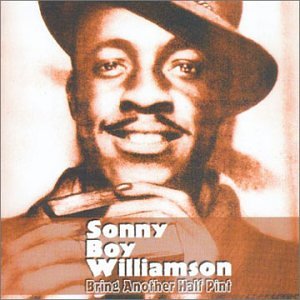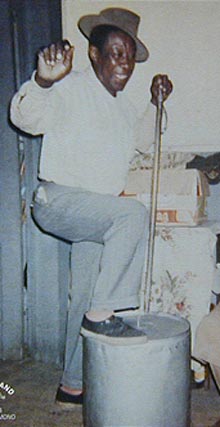Tags
blues harmonica, blues harp, Daddy Stovepipe, Deford Bailey, Eddie Mapp, hammie nixon, jaybird coleman, John Lee Curtis Williamson, John Lee Williamson, Jug Bands, King David Jug Band, Memphis Jug Band, Noah Lewis, rhythm willie, sleepy john estes, Sonny Boy Williamson I, Stovepipe 1, Will Shade
We hear a lot about the ‘amplified’ blues harp greats such as Little Walter and James Cotton (thanks Muddy!) but less is known about more acoustic blues harp players from before 1950’s. So this posting charts a few of the players who blazed their own trail and provided a fertile ground for others to play and dance upon. Let’s start with the more famous John Lee Curtis ‘Sonny Boy’ Williamson who really did change the status of the blues harp and prepared the ground for the explosion of amplified blues harp playing in Chicago in the 50’s.
What is interesting about SBW I is that he straddled the transition between acoustic harp and amplified harp, made many innovations but was not able to capitalise on them as much as SBTII (Aleck Rice Miller).
John Lee Curtis Williamson was born near Jackson, Tennessee in 1914. His original recordings were considered to be in the country blues style, but he soon demonstrated skill at making the harmonica a lead instrument for the blues, and popularized it for the first time in a more urban blues setting. He has often been called “the father of modern blues harp”.
Williamson taught himself the harmonica as a child, influenced by great players like Will Shade and Hammie Nixon from nearby Memphis. At age eleven, he received his first harmonica as a Christmas gift from his mother. According to his half-brother, T. W. Utley, when he was not chopping cotton, milking cows, or doing other farm chores, he was teaching himself to play the harmonica by listening to and playing along with records on an old wind-up record player. By the time he was sixteen, Williamson was jamming around Tennessee and Arkansas with guitarist “Sleepy John” Estes and mandolin demon James “Yank” Rachell.
By the time that he had reached his teens, he was already a master of the instrument. Using the name “Sonny Boy” Williamson, he traveled during the depression, performing with artists like Robert Nighthawk and Sleepy John Estes.
By the time that Williamson arrived in Chicago in 1934, he was a seasoned performer, already stretching the boundaries of harmonica playing.
“He played with all the rhythmic subtlety of the best country blues, slurring and wailing the harp notes, making the harmonica almost a single entity….But gradually the rural sound changed, as if the country boy was wising up to city ways,” wrote Giles Oakley, author of The Devil’s Music: A History of the blues.
His use of his hands and his imaginative fills fit well into the growing “urban” style of blues, increasing the level of expression the instrument could bring to a song. Williamson’s call-and-response method of alternating vocals with instrumental verses has become a blues standard. Of course call and response links back to the original cotton field hollers.
John Lee Williamson is regarded as a musician “who brought the harmonica to prominence as a major blues instrument”. He played a tremendous role in influencing the classic Chicago blues of the 1940’s and 1950’s. Among the artists he has influenced are Billy Boy Arnold, Shakey Jake Harris, Big Walter Horton, Little Walter, Dr. Ross, Junior Wells, and Johnny Young.
Pete Welding, on Blues Classic’s Album 21, described Williamson as “a forceful singer, popular recording artist, and the first truly virtuoso blues harmonica player, whose rich, imaginative solo flights resulted in completely re-shaping the playing approach and the role of his humble instrument in the blues.” Many of his songs are considered today as blues classics.
On June 1, 1948, John Lee Williamson was killed in a mugging on Chicago’s South Side, as he walked home from his final performance at The Plantation Club at 31st St. and Giles Ave., a tavern just a block and a half away from his home at 3226 S. Giles. Williamson’s final words are reported to have been ” Lord have mercy”.
His very first recording, “Good Morning, School Girl“, was a major hit on the ‘race records’ market in 1937. He was hugely popular among black audiences throughout the whole southern United States as well as in the midwestern industrial cities such as Detroit and his home base in Chicago, and his name was synonymous with the blues harmonica for the next decade.
Check out this documentary of the life of John Lee Curtis Williamson:
Some of the following text about some of the early blues harp players has been written by Pat Missin, who has a great ability for serious ethnomusicology and it is worth trawling his web site for all things to do with the history,present and future of the blues harp,harmonica and mouthorgan.
DADDY STOVEPIPE
Johnny Watson, alias Daddy Stovepipe was born in Mobile, Alabama, on April 12th 1867 and died in Chicago, November 1st 1963. A veteran of the turn of the century medicine shows, he was in his late fifties when he became one of the first blues harp players to appear on record in 1924. He later recorded with his wife, Mississippi Sarah, in the 1930s and spent his last years as a regular performer on Chicago’s famous Maxwell Street, where he made his last recordings (issued on LP as Collector’s Issue C-5527, now out of print).Maxwell Street was the home of Bo Diddley, Junior Wells, Little Walter, Uncle Johnnie Williams, Big Bill Broonzy, Papa Charlie Jackson, Arthur Crudup, Hound Dog Taylor, One-Armed John Wrencher, One-legged Sam, Snooky Prior, Sonnyboy Williamson, Muddy Waters, Howlin’ Wolf and countless blues legends.
Take a look at some of the historical footage of the rise and fall of Maxwell Street Chicago:
About the same time as he made his first recordings, another singer was recorded under the name of Stovepipe No.1. These two musicians make an interesting contrast. Both singers accompanied themselves on harmonica and guitar, but Johnny Watson gained his nickname from the stovepipe hat he wore, whereas Stovepipe No.1 (Sam Jones from Cincinnati) actually played a stovepipe, in a manner similar to a jug.
Daddy Stovepipe played the blues almost exclusively on his early records, but used a straight harp style more associated with white folk music. Stovepipe No.1 on the other hand used a bluesy cross harp style, but his issued recordings featured primarily non-blues material.
By 1960, when he was recorded by Paul Oliver, Watson’s repertoire had broadened following many years of busking throughout the country and he was performing such songs as “Tennessee Waltz”, though with an exuberance rare for a man in his nineties.
STOVEPIPE NO. 1 (SAM JONES)
Little is really known about Stovepipe No. 1. His real name was Sam Jones, he was probably from Cincinnati and he made his first records as a “one-man-band” in 1924, as did Daddy Stovepipe. Sam Jones in many ways was the opposite of Johnny Watson (Daddy Stovepipe). His solo records featured old-time tunes with bluesy cross harp playing, unlike Watson’s blues pieces with old-time straight harp.
As you can see he really did play a stovepipe -getting a sound out of it like a jug.
Sam Jones also played with other people (unlike Watson who recorded solo, or in the company of his wife). His work with David Crockett and King David’s Jug Band (along with his solo sides) is available on Stovepipe No. 1: Complete Recorded Works (1924-1950) & The Jug Washboard Band (1928)1.
DEFORD BAILEY
DeFord Bailey was born in Tennessee in 1899 to a musical family and at a very young age took up the harmonica. Crippled by a childhood attack of polio and unable to work on his parents’ farm, DeFord began to earn a living playing his harp on the streets of Nashville. Spotted by a talent scout at a harmonica contest in 1925 (DeFord came second to someone called J.T.Bland, playing a version of “Lost John”) he was invited to play on a radio show called “Barn Dance” later to be known as “The Grand Ole Opry”.
Until the early forties Bailey opened the Saturday night radio show with “Pan-American Blues”, a train imitation piece, but his departure from the show was in less than pleasant circumstances and he retired from music to become a shoe-shine boy.
He was persuaded to play the Opry again in the seventies, but never again recorded and died in July 1982.
Bailey was a very influential player, both through his records and his radio work, leaving an impression on such players as Sonny Terry (who recorded a version of Bailey’s “Alcoholic Blues”), the teenage blues harp virtuoso Eddie Mapp and white country harp player Red Parham. Of Bailey’s two recording sessions, eleven tracks have survived.
EDDIE MAPP
Eddie Mapp’s career is unfortunately rather typical of many blues players in the 1920s and 1930s – after making a few records, he was found dead in the street in Atlanta, Georgia, at the age of twenty. This means that he was just seventeen or eighteen years old at the time of his only recording session in 1929, in the company of guitarists Guy Lumpkin and Slim Barton and harp player James Moore. Mapp’s playing on these sides is very mature for such a young musician and covers a range of different styles.
RHYTHM WILLIE
Little is known for certain about the harp player who called himself Rhythm Willie. He recorded just two sessions under this name, in 1940 and 1950. He is also almost certainly the harp player on some records by the pianists Lee Brown and Peetie Wheatstraw. The harmonica on these pieces is often listed as by Lee McCoy. This could be Willie’s real name, or it could be due to confusion with singer/guitarist/harp player Robert Lee McCoy (who later became better known as Robert Nighthawk). Robert Lee McCoy did record some pieces with Peetie Wheatstraw, but his harp style is very different from Rhythm Willie.
Paul Oliver has suggested that Willie may have been a white musician, but I am not aware of any evidence to support this. Eddie Taylor, longtime friend and partner of Jimmy Reed said that he knew Rhythm Willie. Taylor claimed that Willie was alive in the 1970s and still living in Chicago, but was considered “crazy” and had retired from music, claiming that nobody understood how to play his songs.
Willie’s musical style is rather similar to harp players such as Blues Birdhead, but even more accomplished. Certainly there is a pronounced jazz flavour to his playing, showing a very definite Louis Armstrong influence in particular and this is underlined by his choice of material, particularly in his post-war recording of Gershwin’s “I Got Rhythm”. Willie’s speciality is cleanly played first position harp. In all the recordings of him that I have located, there is nothing played in the cross harp style, but this appears to have been out of choice rather than any lack of skill with the harp.
Willie Hood, known as Rhythm Willie the Harmonica Wizard, was a popular entertainer in Chicago, up until his death in 1954. His repertoire consisted of jazz-tinged blues and, apparently, pop standards of the time. Here, I have transcribed the opening measures to three of the tunes he recorded at a 1940 session, issued under the name “Rhythm Willie and his Gang”. These tracks have been reissued on “Harps, Jugs, Washboards and Kazoos 1926-1940” (RST Records Jazz Perspectives JPCD-1505-21). “Boarding House Blues” is a typical example of Willie’s first position jazz style (everything he recorded, with the exception of “Breathtakin’ Blues” was played in first position, or straight harp), played here on a G harp. Upper octave first position is often referred to as “Jimmy Reed style”, but Willie was playing in this style in the 30s (or maybe even earlier) with a degree of sophistication that Jimmy Reed never achieved.
ref.Pat Missin
Noah Lewis
Lewis was born in Henning, Tennessee around 1890, and raised in the vicinity of Ripley. He was noted for being able to blow two harmonicas at once – through his mouth and his nose.
He played in local string bands and brass bands, and began playing in Ripley and Memphis areas with Gus Cannon. When jug bands became popular in the mid-1920s, he joined Cannon’s Jug Stompers and recorded for Victor Records areas with in January 1928.
The songs from that session included “Minglewood Blues”, “Springdale Blues”, and “Madison Rag”. Gus would spend his weekends in nearby Ripley, and it was here on a Sunday afternoon in that he met Noah Lewis.Noah introduced Gus to Ashley Thompson who played guitar and was only 13 at the time.
The Noah Lewis Jug Band included “Sleepy” John Estes on guitar and Yank Rachel on Mandolin. During the Nov 26 session they recorded New Minglewood Blues. It is this version that most resembles the verions performed by the Grateful Dead (see Roots of the Grateful Dead http://taco.com/roots/roots.html)
On a later recording with the Jug Stompers, “Viola Lee Blues”, he sang lead vocal and played a melancholy harmonica solo.
Viola Lee Blues (Take 1) by Noah Lewis
The judge he pleaded, clerk he wrote it
Clerk he wrote it down indeedy
The judge he pleaded, the clerk he wrote it down
If you miss jail fellas, you must be Nashville bound
Some got six months, some got one solid
Some got one solid year, indeedy
Some got six months, some got one solid year
But me and my buddy both got lifetime here
Fix my supper mama, let me go to her
Let me go to bed, indeed Lord
Fix my supper, let me go to bed
I’ve been drinkin’ white lightnin’
It’s gone to my head
Noah Lewis was also known as a heavy cocaine user (note cocaine was legal and endemic in Memphis pre-WWI)
Will Shade
Back in Memphis, Will Shade (born 2/5/89 in Memphis) had started the Memphis Jug Band. They became very popular in Memphis, often playing in Church Park. Shade was commonly called Son Brimmer, a nickname from his grandmother Annie Brimmer, because “son” is short for “grandson”. The name apparently stuck when other members of the band noticed that the “sun” bothered him and he used the “brim” of a hat to “shade” his eyes.
Shade himself played the guitar, the “bullfiddle” or washtub bass, and the harmonica, the instrument on which he was most influential. His pure country blues harmonica style served as the foundation for later renowned harmonicists like Big Walter Horton and both Sonny Boy Williamson I and II, and Charlie Musselwhite credits him as a mentor. He composed many of the band’s songs and sang lead vocal on a handful of their recordings.
The Memphis Jug Band was formed in the early 1920s to play parties, clubs, and dances. The band’s appeal was universal; they played for tips in Church’s Park (now W.C. Handy Park) on Beale Street, swanky affairs at the Chickasaw Country Club, and for conventions at the Peabody Hotel. The band played the park not only for tips but also to learn new songs from other jug bands, such as Jack Kelly’s Jug Busters (featuring Frank Stokes), the Three “J’s” (featuring Sleepy John Estes), Robert Wilkins’s four-piece outfit, and solo performers Gus Cannon (of Cannon’s Jug Stompers) and Jim Jackson. In testament to their virtuosity, the Memphis Jug Band obtained the most lucrative gigs, including political rallies and private parties for E.H. Crump, Memphis’ notorious mayor.
The Memphis Jug Band first recorded for Victor in February 1927 and over the next four years recorded 57 sides. By 1930 there were seven different jug bands active in Memphis. The Memphis Jug Band had become so popular, and large, that they would split into two versions and play two different gigs on the same night.
The Memphis Jug Band had a fluid membership during the nearly 40 years that it was active, recording under a number of names and in a variety of styles ranging from blues and rags to gospel. All the while, though, Will Shade was the backbone of the group, as he was the one responsible for finding new members to keep the jug band alive. The group’s best material came mainly from him; intelligently, Shade tried, whenever possible, to copyright his music under his name. Besides being the head of the band’s music, Shade was also in charge of the business affairs of the Memphis Jug Band, planning gigs and distributing money.
Various musicians recorded with the band from its first session in February 1927 to its final session in November 1934. These performers included Ben Ramey on kazoo, Will Weldon on guitar and mandolin, “Shakey Walter” Horton on harmonica, Charlie Polk on jug, Vol Stevens on banjo-mandolin (a banjo with a mandolin head), Jab Jones on jug, Hambone Lewis on jug, and vocalist Charlie Nickerson. In 1928, Charlie Burse joined the band as a permanent fixture on guitar and mandolin. The Memphis Jug Band frequently recorded with female singer Hattie Hart and with singer/guitarist Memphis Minnie on one occasion.
The Great Depression, coupled with a concerted police crackdown on gambling in 1930, caused hard times on previously wide-open Beale Street. The jug band craze also subsided in the 1930s, bringing fewer recording opportunities and smaller tips. The band tried to update to a jazzier sound for their final recording date, but commercial success had passed. The Memphis Jug Band’s best records epitomize the Roaring Twenties in Memphis.
Blues researcher Samuel Charters found Will Shade and his old cohorts in 1956 still playing together and released several field recordings under the Memphis Jug Band name. The band during this period usually included Shade’s long time friend Charlie Burse, whom Shade had picked up in 1928 as a vocalist and tenor guitarist, and sometimes included old rival Gus Cannon. Shade also appeared as an accompanist on Cannon’s “comeback” album, Walk Right In, recorded by Stax Records in 1963. Will Shade continued to put together jug bands in the 1940s, often with Charlie Burse. The two were rediscovered and recorded by. Will Shade died of pneumonia on September 18, 1966.
(refs Wikipedia http://en.wikipedia.org/wiki/Will_Shade and http://www.allaboutjazz.com/php/musician.php?id=9326).
I was reminded by barbad of two other harmonica stars:
Burl C. ‘Jaybird’ Coleman (1896 -1950)
He was born, raised and worked on a farm, and picked up and learned the harmonica at 12 years of age. Coleman began performing the blues as an entertainer for American soldiers while serving in the United States Army. It was during this period that he was given the nickname “Jaybird” due to his independent manner. In the early 1920s, he teamed with fellow bluesman Big Joe Williams as a performer in the Birmingham Jug Band which toured through the American South.
Coleman made his first recordings as a solo artist in 1927. His career as a recording artist lasted only until 1930, after which he performed mostly on street corners throughout Alabama.
Hammie Nixon
Harmonica player Hammie Nixon was born on January 22, 1908, in Brownsville, TN. An orphan at a young age, he was raised by foster parents. He began his career as a professional harmonical player in the 1920s, but also played the kazoo, guitar, and jug. He performed with Sleepy John Estes for more than 50 years, first recording withEstes in 1929 for the Victor label. He also recorded with Little Buddy Doyle, Lee Green, Charlie Pickett, and Son Bonds.
Nixon helped to pioneer the use of the harmonica as an accompaniment instrument with a band in the 1920s. Previous to that time, it had been mostly a solo instrument. He played with many jug bands. After Estes died, Nixon played with the Beale Street Jug Band (also called the Memphis Beale Street Jug Band) from 1979 onward. Hammie Nixon died August 17, 1984. (from all music)
Here Hammie Nixon is seen playing live with Sleepy John Estes – ‘I aint gonna sell it ‘-playing together in 1976
Again playing with his friend Sleepy John Estes and showing his skill on ‘wah wah’ -Someday Baby…
and a nice version of the classic Corrine Corrine..the great pair working together once again, Hammie with some good jug band sounds
For more recordings check these:






















Good stuff, kudos for including rhythm willie in particular
I can’t find your original post but I hope you included Jaybird Coleman, Bob Cooksey and Hammie Nixon on it
Thanks for your comment and I will now update the post with your suggestions.
Ray
hi barbad,love your video collections of blues artists.ray